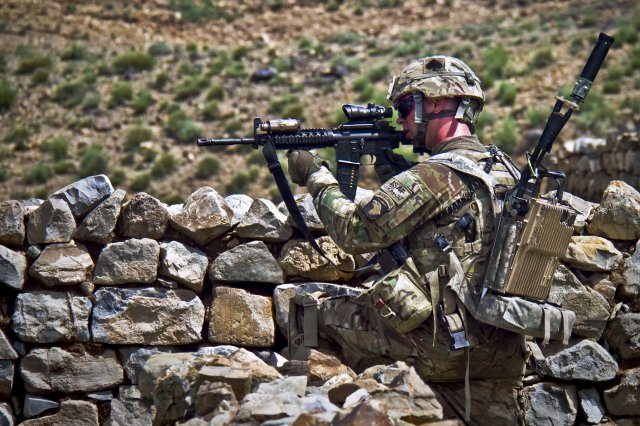September is Suicide Prevention Month and the Department of the Army joins our nation and the world in observing National Suicide Prevention Week, Sept. 8-14, 2013, in the U.S. and the World Health Organization’s World Suicide Prevention Day, Sept. 10, as part of efforts to promote awareness about suicide and empower individuals and communities to intervene and save lives by understanding the risk factors, warning signs, protective measures, and to take appropriate intervention actions when needed.
The Army’s leadership role in the fight to prevent suicide is to increase awareness of the Army’s suicide prevention resources, and continued efforts to educate, empower, and equip Soldiers, families and Department of the Army Civilians to seek help for life stressors and intervene to aid others who display at-risk behaviors.
The end state is a more informed and resilient Army family and a climate where Soldiers, families, and civilians seek help when needed and are empowered to intervene and act to save lives.
“We call on each of you to act, know your Soldier, and know the existing prevention resources,” said Lt. Gen. Patricia D. Horoho, Army surgeon general and commander of the U.S. Army Medical Command. “These tools are key to self care and sustainment of our Army family.”
In March 2009, in response to a growing number of Army suicides, the vice chief of staff of the Army released the Army Campaign Plan for Health Promotion, Risk Reduction and Suicide Prevention, and chartered the Army Suicide Prevention Task Force and the Army Suicide Prevention Council. Since that time, the Army has invested tremendous effort in investigating the causes of suicide within its ranks and in implementing policies and programs whose sole purpose is to promote resilience, prevent suicides, and enhance the readiness of the force. One such program is the Performance Triad, which focuses on monitoring one’s activity, nutrition and sleep as a means of fortifying Soldiers’ readiness and resilience.
In 2012, the Army doubled its efforts towards reducing the stigma associated with seeking behavioral healthcare. To address this tragic problem, the Army has instituted a multi-disciplinary, holistic approach to health promotion, risk reduction, and suicide prevention that addresses the many challenges our Soldiers, families, and Army civilians face.
“From our individual Soldiers and civilians to our units and families, we must be committed to investing in building enduring strength in a holistic way,” said John M. McHugh, secretary of the Army.
On Sept. 27, 2012, the U.S. Army conducted phase one (awareness and education) of an Army-wide suicide prevention stand down to empower leaders, Soldiers, families and civilians. During phase one, leaders conducted discussions with Soldiers and used the Leader Risk Reduction Tool (specifically developed for this purpose), conducted community and family-oriented events, and identified local programs, and resiliency training. The resources developed and utilized during the stand down are housed on the website of the Army Human Resources Group (Army G-1). The following day, phase two of the stand down began and continues today. Phase two (training and sustainment) will continue indefinitely.
Suicide prevention continues to be one of the most pressing ‘Health of the Force’ issues. Army leaders are committed to maintaining a supportive environment that improves the physical, emotional, and psychological resiliency of our Soldiers, families, civilians and individual/unit readiness. With the implementation of the 2020 Army Strategy for Suicide Prevention, the Army will attempt to shift its culture by increasing the emphasis on leader involvement to protect and promote life.
Army regulations governing health promotion, risk reduction, and suicide prevention describe suicide prevention as a continuum of awareness, intervention, and “postvention” [sic] to help save lives. Ultimately, the goal of prevention is to develop healthy, resilient Soldiers to the point where suicide is not an option.
The Ready and Resilient Campaign exemplifies the Army’s collaborative, holistic approach, which tailors suicide intervention, prevention, and response measures to ensure Soldier resilience. As a comprehensive plan addressing the immediate and enduring needs of the total Army — active duty, Reserve, and National Guard Soldiers, their families, and Department of Army Civilians, this campaign synchronizes and integrates key Army programs that focus on building resilience, reinforcing prevention, and supporting the reduction of suicide and suicidal ideation, sexual harassment and sexual assault, bullying and hazing, substance abuse, domestic violence; and stigma associated with seeking help.
Suicide is a multi-faceted problem that requires an equally sophisticated response. Life stressors including behavioral health issues, relationship difficulties, physical illness, and financial and legal problems can all weigh heavily on an individual, engendering feelings of burdensomeness and hopelessness. As these difficulties and feelings, real and/or perceived multiply within an individual, suicide can become an increasingly viable solution — a permanent solution for a temporary problem.
“Each suicide is a tragic loss for the Army family and America,” said Horoho. “As leaders it is our responsibility to end hazing, harassment, discrimination, and any behavior that runs counter to Army values. Empower those you lead to always intervene and act to save lives.”
For more than a decade, Army leadership has been up front in the creation and establishment of suicide prevention policy and innovative initiatives to bridge available resources with current needs. Over the past several years there has been a decrease in the percentage of Soldiers that hold views that bar them from seeking help. At the same time, the number of Soldiers who are using treatment programs such as behavioral health and substance abuse has steadily increased which indicates Soldiers are overcoming those stigma barriers. It will take time to change this culture, but through actions and example, Army leaders are beginning that transformation.
Defeating suicide will take active involvement from everyone. People can get involved and engage those struggling with setbacks and challenges.











